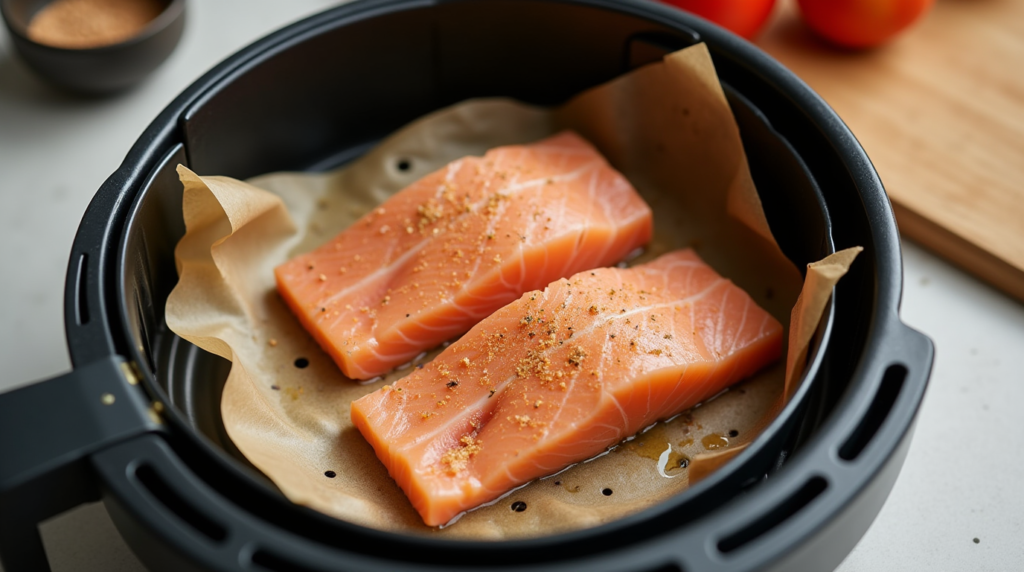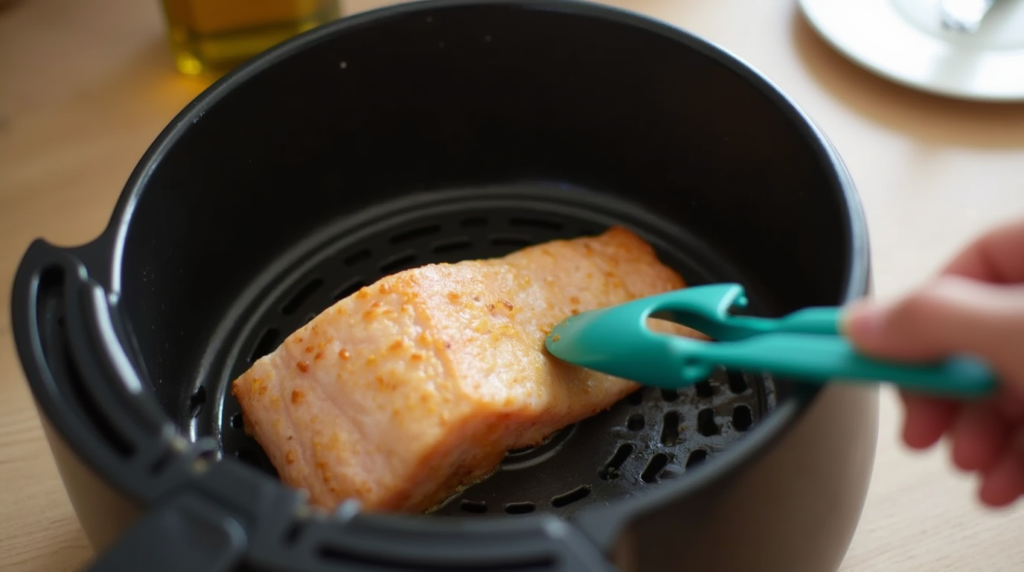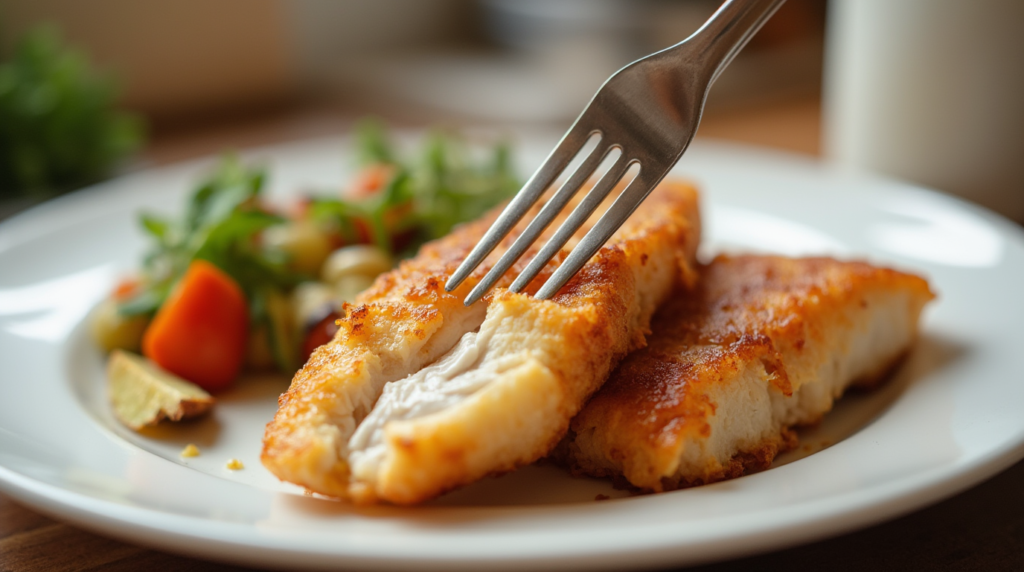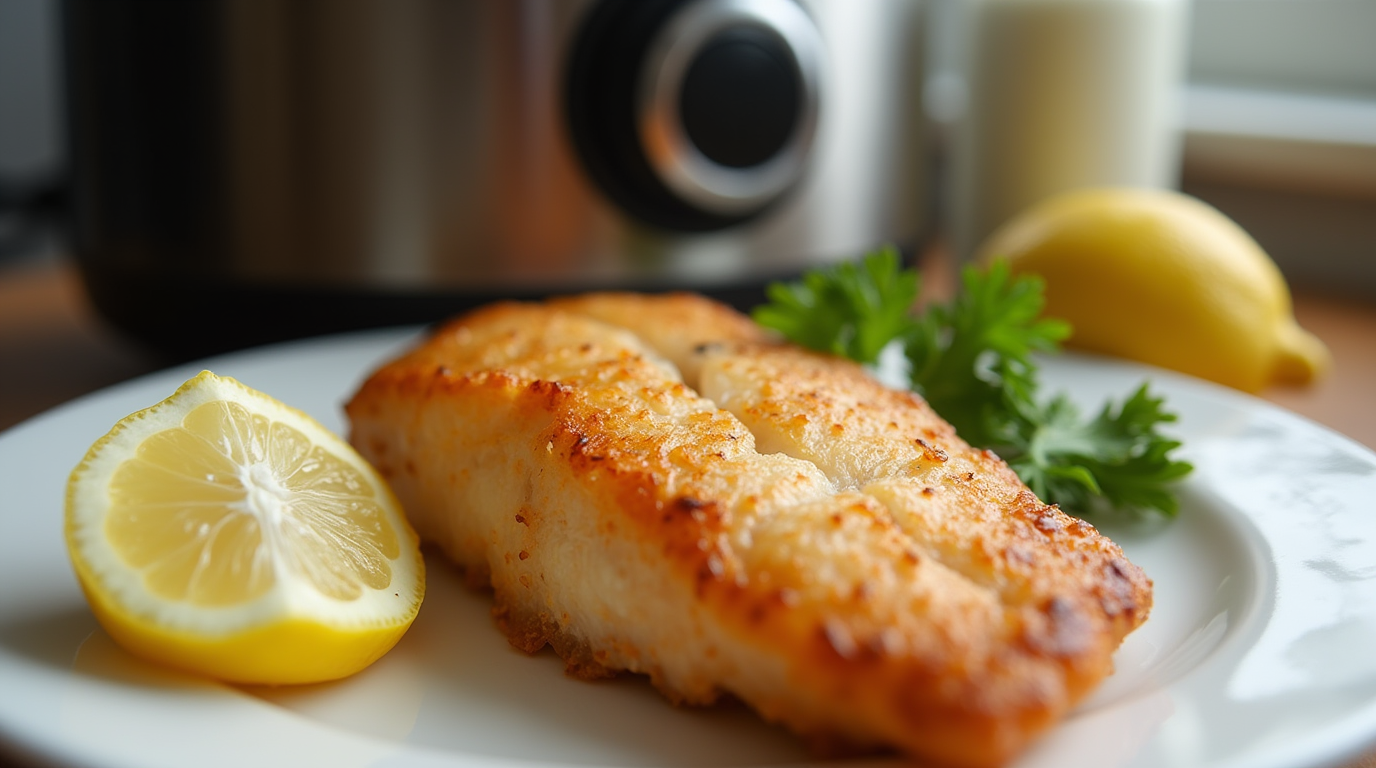Cooking fish in the air fryer is, without a doubt, a simple, quick, and healthy way to prepare seafood. But do you flip fish in the air fryer? Absolutely! Flipping the fish during cooking is key to getting even crispness and avoiding sticking or breaking. This step, moreover, improves both texture and taste, giving you a nice presentation.
Whether you’re making a quick dinner or an impressive meal for guests, flipping, consequently, makes a big difference. For more detailed instructions on air frying fish, including precise times and temperatures, check out our guide on how long to air fry fish fingers.
Why Flipping Fish in the Air Fryer Matters
Ensuring Even Cooking
Achieving perfectly cooked food in the air fryer requires careful attention to technique for even cooking. Uneven cooking often results in some parts overcooking while others stay undercooked. Here are key strategies to ensure even results every time you use your air fryer:
- Preheat the Air Fryer
Preheating helps the air fryer reach the right temperature, ensuring consistent cooking from the start. - Avoid Overcrowding the Basket
Arrange food in a single layer with space between pieces. This setup allows hot air to circulate evenly. - Shake or Flip the Food
Shake the basket or flip the food halfway through cooking to expose all sides to the heat. - Cut Food into Even Sizes
Uniformly cut pieces cook at the same rate, preventing smaller pieces from overcooking. - Use Accessories Wisely
Racks or skewers can help cook multiple layers while maintaining proper air circulation.
Achieving a Crispy Texture on Both Sides
Using an air fryer, without a doubt, delivers crispy, golden-brown results with minimal oil. However, achieving even crispiness on both sides, indeed, requires proper technique. Here are some essential tips, consequently, to help you get the perfect crunch:
- Preheat the Air Fryer
- Why It Matters: Preheating, undoubtedly, ensures food starts crisping immediately, promoting an even texture.
- Tip: Preheat for 3–5 minutes before adding food.
- Use a Light Coating of Oil
- Why It Matters: A thin oil layer, moreover, helps create a golden, crispy exterior. Too much oil, consequently, leads to sogginess.
- Tip: Use a spray bottle or brush to coat food evenly with oil.
- Flip or Turn Halfway Through
- Why It Matters: Air fryers, indeed, circulate heat from the top. Flipping food, therefore, ensures even crisping.
- Tip: For delicate items like fish fillets, use a silicone spatula or tongs to flip gently.
- Don’t Overcrowd the Basket
- Why It Matters: Overcrowding, consequently, blocks airflow and prevents even crisping.
- Tip: Arrange food in a single layer with space between pieces. Cook in batches if needed.
- Use Parchment Paper with Holes
- Why It Matters: Perforated parchment, indeed, prevents sticking while allowing airflow.
- Tip: Ensure the paper, consequently, doesn’t block air circulation.
- Adjust Temperature for Crisping
- Why It Matters: Higher temperatures (375°F–400°F), moreover, are ideal for a crispy texture.
- Tip: Increase heat slightly in the last 2–3 minutes for extra crunch.
- Pat Food Dry Before Cooking
- Why It Matters: Excess moisture, undoubtedly, hinders browning and crisping.
- Tip: Pat food dry with a paper towel before seasoning.
- Use Breading or Coating
- Why It Matters: Breadcrumbs or panko, consequently, create a crunchy layer.
- Tip: Lightly spray the coating with oil and flip halfway through cooking.
Preventing Fish from Sticking to the Basket
Cooking fish in the air fryer, without a doubt, is a healthier and more convenient alternative to frying. However, one common issue, indeed, is fish sticking to the basket. Delicate fillets, consequently, can tear or break apart, affecting presentation and texture. Here are effective tips, therefore, to prevent fish from sticking:
- Preheat the Air Fryer
- Why It Matters: A preheated basket helps create an immediate sear on the fish, reducing the chance of sticking.
- Tip: Preheat the air fryer for 3-5 minutes before placing your fish inside.
- Use Non-Stick Spray or Oil
- Why It Matters: Lightly coating the basket with oil or non-stick cooking spray creates a barrier that helps prevent sticking.
- Tip: Use a neutral oil (like canola, avocado, or olive oil) and spray both the basket and the fish.
- Line with Parchment Paper or a Silicone Mat
- Why It Matters: Parchment paper with perforations or a silicone mat reduces direct contact between the fish and the metal basket, preventing sticking while allowing airflow.
- Tip: Ensure the parchment paper or mat doesn’t block air circulation and fits snugly in the basket.
- Use a Light Coating on the Fish
- Why It Matters: A light coating of oil or a breading (like panko, breadcrumbs, or flour) on the fish itself can help form a protective barrier.
- Tip: Brush a thin layer of oil onto both sides of the fillet or lightly dust it with flour before air frying.
- Avoid Moving the Fish Too Early
- Why It Matters: When cooking starts, the fish can initially stick, but as it cooks, it naturally releases from the surface.
- Tip: Let the fish cook undisturbed for a few minutes before flipping or removing it.
- Use Gentle Tools for Flipping
- Why It Matters: Delicate fish fillets can break easily when flipped.
- Tip: Use a silicone spatula or tongs to carefully lift and flip the fish, supporting the fillet to avoid tearing.
- Don’t Overcrowd the Basket
- Why It Matters: Overcrowding can cause fish fillets to stick to each other or to the basket.
- Tip: Place fillets in a single layer with space between them for proper air circulation.
- Clean the Basket Thoroughly
- Why It Matters: Residue from previous cooking sessions can make fish more likely to stick.
- Tip: Always clean the basket after each use, ensuring no leftover particles remain.

How to Properly Flip Fish In An Air Fryer
Tools You Need for Flipping Fish In An Air Fryer
Flipping fish in the air fryer, without a doubt, can be tricky due to its delicate texture. Using the right tools, consequently, helps keep fillets intact and ensures an even, crispy finish. Here are the best tools, indeed, for flipping fish safely and effectively:
- Silicone Spatula
- Why It’s Useful: A silicone spatula, undoubtedly, is flexible, heat-resistant, and gentle on fish fillets. It, moreover, glides smoothly under fish without scratching the basket.
- Best For: Flipping fillets like tilapia, cod, or salmon.
- Tongs with Silicone Tips
- Why It’s Useful: Silicone-tipped tongs, consequently, provide a firm grip while being gentle on fish and the basket.
- Best For: Flipping thicker fish like salmon steaks or breaded fillets.
- Fish Turner
- Why It’s Useful: A fish turner, indeed, has a wide, slotted blade for extra support. The slots, moreover, help drain oil while lifting.
- Best For: Handling large or thin fillets without breaking them.
- Perforated Parchment Paper
- Why It’s Useful: This paper, undoubtedly, reduces sticking and allows easy flipping. The holes, moreover, ensure proper airflow.
- Best For: Preventing fish from sticking to the basket.
- Heat-Resistant Gloves
- Why It’s Useful: These gloves, consequently, protect your hands when adjusting hot trays or baskets.
- Best For: Safely handling hot items during flipping.
- Flexible Metal Spatula
- Why It’s Useful: This tool, indeed, slides easily under fish for precise flipping.
- Best For: Non-coated trays or when using parchment paper.
By using these tools, you can, consequently, flip fish safely and achieve perfect air-fried results every time.

Step-by-Step Guide to Flipping Fish In An Air Fryer
Flipping fish in the air fryer, without a doubt, helps ensure even cooking and a crispy texture. Because fillets are delicate, using the right technique is key.
Follow these steps for the best results:
- Preheat the Air Fryer
- Why: Preheating ensures even cooking.
- How: Preheat for 3–5 minutes at 375°F to 400°F (190°C to 200°C).
- Lightly Oil Basket and Fish
- Why: Oil prevents sticking and promotes crispiness.
- How: Lightly coat the basket and fillets with oil.
- Arrange in a Single Layer
- Why: Proper spacing allows air to circulate.
- How: Place fillets with space between each piece.
- Cook Partially
- Why: Firming up the fish makes flipping easier.
- How: Cook for half the total time (e.g., 5 minutes if cooking for 10).
- Use the Right Tools
- Tools: Silicone spatula and tongs for gentle flipping.
- Flip Carefully
- How: Slide the spatula under the fillet and use tongs to support the top. Flip gently in one smooth motion.
- Finish Cooking
- How: Cook until golden brown and the internal temperature reaches 145°F (63°C).
- Tips:
- Don’t rush flipping.
- If stuck, gently loosen with a spatula.
- Use perforated parchment paper to reduce sticking.
By following these steps, you’ll achieve perfectly cooked, crispy fish every time.
Timing for Flipping Fish
Flipping fish in the air fryer, without a doubt, is key to achieving an even, crispy texture. Since fish cooks quickly, timing your flip correctly, indeed, ensures the fillets stay intact and don’t dry out.
General Timing Guidelines
- For Thin Fish Fillets (e.g., Tilapia, Sole, Flounder):
- Total Cooking Time: 6-8 minutes
- Flip Timing: After 3-4 minutes
- For Medium-Thick Fillets (e.g., Cod, Haddock):
- Total Cooking Time: 8-10 minutes
- Flip Timing: After 4-5 minutes
- For Thick Fillets or Steaks (e.g., Salmon, Tuna Steaks, Halibut):
- Total Cooking Time: 10-12 minutes
- Flip Timing: After 5-6 minutes
- For Breaded or Battered Fish:
- Total Cooking Time: 10-12 minutes
- Flip Timing: After 5-6 minutes to achieve even crisping on both sides.
Step-by-Step Process for Timing the Flip
- Start Cooking: Place the fish in the preheated air fryer and set the timer according to the total cooking time for your fillet type.
- Halfway Point: When the timer reaches the halfway point (3-6 minutes, depending on fillet thickness), it’s time to flip the fish.
- Flip Carefully: Use a silicone spatula or fish turner to gently flip the fillet, ensuring it doesn’t break apart.
- Finish Cooking: Resume cooking for the remaining time, checking for doneness at the end.
Signs It’s Time to Flip
- Firming Edges: The edges of the fish start to firm up and lift slightly from the basket.
- Color Change: The bottom side shows a light golden color.
- Texture: The fillet feels firmer and less fragile, making it easier to handle.
Tips for Success
- Preheat the Air Fryer: Preheating helps the fish cook evenly and reduces sticking.
- Monitor Closely: Fish cooks quickly, so check a minute before the halfway mark if you’re unsure.
- Avoid Overcooking: Fish should be cooked to an internal temperature of 145°F (63°C). It should be opaque and flake easily with a fork.
By following these timing guidelines, you can confidently flip fish in the air fryer for evenly cooked, delicious results every time.

FAQs About Flip Fish In An Air Fryer
Do You Need to Flip All Types of Fish?
No, not always. For pan-frying or grilling, flipping ensures even cooking. For baking, steaming, or poaching, flipping isn’t necessary.
How Often Should You Flip Fish?
Flip fish only once. Multiple flips can break delicate fillets. Cook until golden on one side, then flip to finish.
Can You Cook Fish Without Flipping It?
Yes. Baking, broiling, steaming, or poaching cooks fish evenly without flipping.
What Happens If You Don’t Flip Fish in the Air Fryer?
If you don’t flip fish in the air fryer, it may cook unevenly. The side facing the heating element will become crispier, while the underside may remain softer or slightly undercooked. Flipping halfway through ensures both sides cook evenly and achieve a consistent texture. However, for thin fillets or if using perforated parchment paper, flipping may not be necessary.
How Do You Keep Fish from Sticking?
Preheat the pan, lightly oil the fish and surface, and use non-stick cookware. Let the fish cook undisturbed until it releases naturally. For baking, use parchment paper or foil.
What’s the Best Tool for Flipping Fish in an Air Fryer?
A silicone spatula or tongs are ideal for flipping fish in an air fryer. They are gentle on delicate fillets and won’t damage the air fryer basket.
Conclusion
Flipping fish in the air fryer, without a doubt, is a simple yet essential step. This technique, indeed, makes a big difference in the quality of your dish. By flipping fillets halfway through, you ensure even cooking, consequently achieving a crispy texture on both sides. Additionally, flipping helps maintain a beautifully intact presentation.
Moreover, this step prevents sticking, avoids overcooking, and guarantees a perfectly golden finish. As a result, your fish turns out both delicious and visually appealing.
Mastering this technique, consequently, will elevate your air fryer cooking skills. You’ll consistently create fish dishes, without a doubt, that are crisp, flavorful, and satisfying. Whether you’re making a quick family dinner or preparing a special meal, flipping fish, indeed, is the key to air fryer success.

